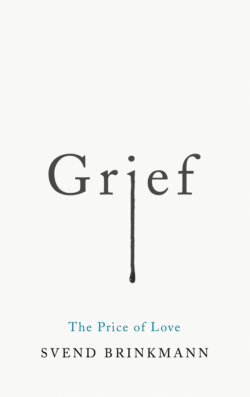Читать книгу Grief - Svend Brinkmann - Страница 9
Science, art and culture
ОглавлениеAlthough the book primarily seeks to convey general psychological perspectives on grief, I also wish to illustrate the discussion with references to various cultural and artistic idioms, including poetry and fiction (e.g. Joan Didion, Naja Marie Aidt), TV shows (e.g. Black Mirror), visual art (e.g. van Gogh, Munch) and theatre (both Greek tragedies and modern experimental drama). The point of this is not just to make the book more accessible. Rather, it reflects my conviction that art is more than an expression of an artist’s irrational creative power, devoid of context – it is a systematic study of the many dimensions and phenomena of human experience, including grief. Science studies the world through its special methods and then conveys the results, but art does more than merely narrate – it also shows the phenomena being examined, which facilitates a more nuanced understanding than is possible with linear research methods. With this in mind, I hope that the book will prove useful to professionals in areas like psychology, psychiatry, philosophy, sociology, anthropology and theology, as well as to anyone interested in grief as a basic human experience. Although the book is primarily about grief as an emotion that usually follows the death of someone close, it also identifies grief as a basic existential state that is better encapsulated by art than by science. In his poetry collection Rystet spejl (Shaken Mirror), Søren Ulrich Thomsen writes of loss:
Little children too dream of their past
which is huge and dusky
full of scents and unrecognizable figures
reflected in polished floors.
Even the very old feel bereft
when they sit staring in dayrooms
and suddenly remember
that they have lost their parents.3
As human beings, the bonds we forge with others are both a gift and a curse – as such, grief is a lifelong companion. This mournful, melancholic undertone to life appears quite at odds with our positivity-oriented, happiness-obsessed age, and yet there is good reason to dwell on it, because it represents something deeply human. The sociologist Clive Seale has conducted detailed analyses of the significance of death and grief to society. As well as relating to the ‘big grief’ that follows a death, he also describes the ‘little grief’ that constantly lurks just below the surface in beings like us, who live in vulnerable bodies and know that death is an inescapable reality for us all (Seale 1998). Heidegger (1962), too, cast human existence as essentially ‘being-toward-death’. We regularly experience minor senses of loss, for example when social bonds are broken in more or less dramatic ways. Seale writes that what we call grief is basically an extreme version of the ‘everyday sadness’ that confronts us when we try to turn our attention away from our finitude toward the business of getting on with our lives (Seale 1998: 211). Seale belongs to a group of sociologists and social psychologists who consider human knowledge of and respect for mortality to be an important foundation for the formation and maintenance of human society. He writes that all social and cultural life is ultimately ‘a human construction in the face of death’. For this reason, all social life is also ‘a defense against the “grief” caused by realisation of embodiment’ (1998: 8). The sociologist Peter Berger propounds a similar idea, that societies should be understood as consisting of people who have joined together in the face of death (referred to in Walter 1999: 21). Ernest Becker, in his classic 1973 book The Denial of Death, describes the fear of death as the main human condition and the engine behind social processes (Becker 2011). Hegel supposedly said a couple of centuries ago that, at its core, the history of the world is about the way in which humans relate to death (see Jacobsen 2016: 19). This book seeks to resurrect phenomenological thinking about the concept of existence and illustrate the relevance of phenomenology to social and psychological analyses, not least concerning the constitutive function of grief for both the self and society.
